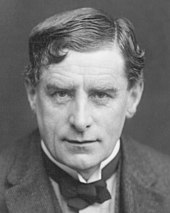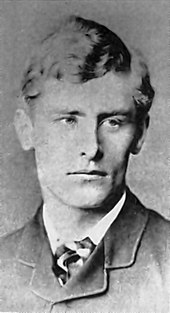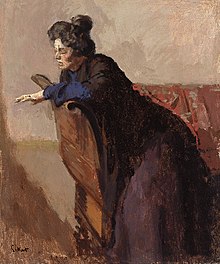Walter Sickert
From Wikipedia, the free encyclopedia

Walter Sickert, photograph by George Charles Beresford, 1911
Sickert was a cosmopolitan and eccentric who often favoured ordinary people and urban scenes as his subjects. His oeuvre also included portraits of well-known personalities and images derived from press photographs. He is considered a prominent figure in the transition from Impressionism to Modernism.
Contents
Training and early career
Sickert was the eldest son of Oswald Sickert, a Danish-German artist, and his wife, Eleanor Louisa Henry, who was an illegitimate daughter of the British astronomer Richard Sheepshanks.[1] In 1868, the family left Munich to settle in Britain, where Oswald's work had been recommended by Freiherrin Rebecca von Kreusser to Ralph Nicholson Wornum, who was Keeper of the National Gallery at the time.[2] The young Sickert was sent to University College School from 1870–1871, before transferring to King's College School, where he studied until the age of 18. Though he was the son and grandson of painters, he first sought a career as an actor; he appeared in small parts in Sir Henry Irving's company, before taking up the study of art in 1881. After less than a year's attendance at the Slade School, Sickert left to become a pupil and etching assistant to James Abbott McNeill Whistler.[3] Sickert's earliest paintings were small tonal studies painted alla prima from nature after Whistler's example.[4]In 1883, he travelled to Paris and met Edgar Degas, whose use of pictorial space and emphasis on drawing would have a powerful effect on Sickert's work. He developed a personal version of Impressionism, favouring sombre colouration. Following Degas' advice, Sickert painted in the studio, working from drawings and memory as an escape from "the tyranny of nature".[4] In 1888 Sickert joined the New English Art Club, a group of French-influenced realist artists. Sickert's first major works, dating from the late 1880s, were portrayals of scenes in London music halls. One of the two paintings he exhibited at the NEAC in April 1888, Katie Lawrence at Gatti's, which portrayed a well known music hall singer of the era, incited controversy "more heated than any other surrounding an English painting in the late 19th century".[5] Sickert's rendering was denounced as ugly and vulgar, and his choice of subject matter was deplored as too tawdry for art, as female performers were popularly viewed as morally akin to prostitutes.[6] The painting announced what would be Sickert's recurring interest in sexually provocative themes.
In the late 1880s, Sickert spent much of his time in France, especially in Dieppe, which he first visited in mid-1885, and where his mistress, and possibly his illegitimate son, lived. During this period Sickert began writing art criticism for various publications. Between 1894 and 1904 Sickert made a series of visits to Venice, initially focussing on the city's topography; it was during his last painting trip in 1903–04 that, forced indoors by inclement weather, he developed a distinctive approach to the multiple figure tableau that he further explored on his return to Britain.[7] The models for many of the Venetian paintings are believed to have been prostitutes, with whom Sickert may have had physical relations.[8]

The Acting Manager or Rehearsal: The End of the Act, (portrait of Helen Carte), c. 1885
While the painterly handling of the works inspired comparison to Impressionism, and the emotional tone suggested a narrative more akin to genre painting, specifically Degas's Interior,[12] the documentary realism of the Camden Town paintings was without precedent in British art.[13] These and other works were painted in heavy impasto and narrow tonal range. Sickert's best known work, Ennui (c. 1913), reveals his interest in Victorian narrative genres. The composition, which exists in at least five painted versions and was also made into an etching, depicts a couple in a dingy interior gazing abstractedly into empty space, as though they can no longer communicate with each other.
Just before World War I he championed the avant-garde artists Lucien Pissarro, Jacob Epstein, Augustus John and Wyndham Lewis. At the same time he founded, with other artists, the Camden Town Group of British painters, named from the district of London in which he lived. This group had been meeting informally since 1905, but was officially established in 1911. It was influenced by Post-Impressionism and Expressionism, but concentrated on scenes of often drab suburban life; Sickert himself said he preferred the kitchen to the drawing room as a scene for paintings.[14] From 1908–1912 and again from 1915–1918, Sickert was an influential teacher at Westminster School of Art, where David Bomberg was one of his students. He also briefly set up an art school in Manchester where his students included Harry Rutherford.
Late period
After the death of his second wife in 1920, Sickert relocated to Dieppe, where he painted scenes of casinos and café life until his return to London in 1922. In 1924 he was made an Associate of the Royal Academy. In 1926 he suffered an illness, thought to be a slight stroke.[15] The following year, he abandoned the use of his first name in favor of his middle name, and thereafter chose to be known as Richard Sickert.[16] His style and subject matter also changed: Sickert essentially stopped drawing, and instead painted usually from snapshots taken by his third wife, Thérèse Lessore, or from news photographs. The photographs were squared up for enlargement and transferred to the canvas, with their pencil grids plainly visible in the finished paintings. Seen by many of his contemporaries as evidence of the artist's decline, Sickert's late works are also the his most forward-looking, and prefigure the practices of Chuck Close and Gerhard Richter.[17] Other paintings from Sickert's late period were adapted from illustrations by Victorian artists such as Georgie Bowers and John Gilbert. Sickert, separating these illustrations from their original context and painting them in poster-like colours so that the narrative and spatial intelligibility partly dissolved, called the resulting works his "English Echoes".[18]Sickert painted an informal portrait of Winston Churchill c. 1927.[19] Churchill's wife Clementine introduced him to Sickert, who had been a friend of her family. The two men got along so well that Churchill, whose hobby was painting, wrote to his wife that "He is really giving me a new lease of life as a painter."[20]

Henry Tonks. Sodales: Mr Steer and Mr Sickert, 1930
One of Sickert's closest friends and supporters was newspaper baron Lord Beaverbrook, who accumulated the largest single collection of Sickert paintings in the world. This collection, with a private correspondence between Sickert and Beaverbook, is in the Beaverbrook Art Gallery in Fredericton, New Brunswick, Canada. In addition to having painted Beaverbrook, Sickert painted portraits of notables including Gwen Ffrangcon-Davies, Hugh Walpole, Valentine Browne, 6th Earl of Kenmare, and less formal depictions of Aubrey Beardsley, King George V, and Peggy Ashcroft.
Sickert's sister was Helena Swanwick, a feminist and pacifist active in the women's suffrage movement.
Sickert died in Bath, Somerset in 1942, at the age of 81. He had been married three times: from 1885 until their divorce in 1899 to Ellen Cobden, a daughter of Richard Cobden; from 1911 until her death in 1920 to Christine Angus; and from 1926 until his death to the painter Thérèse Lessore.[24]
Style and subjects
For his earliest paintings, Sickert followed Whistler's practice of rapid, wet-in-wet execution using very fluid paint. He subsequently adopted a more deliberate procedure of painting pictures in multiple stages, and "attached a great deal of importance to what he called the 'cooking' side of painting".[25] He preferred to paint not from nature but from drawings or, after the mid-1920s, from photographs or from popular prints by Victorian illustrators. After transferring the design to canvas by the use of a grid, Sickert made a rapid underpainting using two colours, which was allowed to dry thoroughly before the final colours were applied. He experimented tirelessly with the details of his method, always with the goal, according to his biographer Wendy Barron, of "paint[ing] quickly, in about two sittings, with the maximum economy and minimum of fuss".[26]Sickert tended to paint his subjects in series.[27] He is identified particularly with domestic interior scenes, scenes of Venice, music hall and theatre scenes, and portraits. He painted very few still lifes. For his music hall subjects, Sickert often chose complex and ambiguous points of view, so that the spatial relationship between the audience, performer and orchestra becomes confused, as figures gesture into space and others are reflected in mirrors.[28] The isolated rhetorical gestures of singers and actors seem to reach out to no-one in particular, and audience members are portrayed stretching and peering to see things that lie beyond the visible space. This theme of confused or failed communication between people appears frequently in his art. By emphasising the patterns of wallpaper and architectural decorations, Sickert created abstract decorative arabesques and flattened the three-dimensional space. His music hall pictures, like Degas' paintings of dancers and café-concert entertainers, connect the artificiality of art itself to the conventions of theatrical performance and painted backdrops.
The paintings of the Camden Town Murder series of c. 1908 were painted in heavy impasto and narrow tonal range, as were numerous other obese nudes in the pre-World War I period in which the fleshiness of the figures is connected to the thickness of the paint—a device that was later adapted by Lucian Freud. The influence of these paintings on successive generations of British artists has been noted in the works of Freud, David Bomberg, Francis Bacon, Frank Auerbach, Howard Hodgkin, and Leon Kossoff.[29]
In the 1910s and '20s, the dark, gloomy tones of his early paintings gradually brightened,[27] and Sickert juxtaposed unexpected tones with a new boldness in works such as Brighton Pierrots (1915) and Portrait of Victor Lecourt (1921–24). His several self-portraits usually displayed an element of role-playing consistent with his early career as an actor: Lazarus Breaks his Fast (c. 1927) and The Domestic Bully (c. 1935–38) are examples.
Sickert insisted on the importance of subject matter in art, saying that "all the greater draughtsmen tell a story",[22] but treated his subjects in a detached manner. According to the painter Frank Auerbach, "Sickert's detachment became increasingly evident in his uninhibited procedures. He made obvious his frequent reliance on snapshots and press photographs, he copied, used and took over the work of other, dead, artists and made extensive use, also, of the services of his assistants who played a large and increasing part in the production of his work."[30]
Jack the Ripper
Although for over 70 years there was no mention of Sickert's being a suspect in the Ripper crimes, in modern times three books have been published whose authors maintain that Sickert was Jack the Ripper or his accomplice.
- In 1976, Stephen Knight, in his book Jack the Ripper: The Final Solution, maintained that Sickert had been forced to become an accomplice in the Ripper murders. Knight's information came from Joseph Gorman, who claimed to be Sickert's illegitimate son. Even though Gorman later admitted he had lied, Knight's book was responsible for a conspiracy theory that accuses royalty and freemasonry of complicity in the Ripper murders.
- In 1990, Jean Overton Fuller, in her book Sickert and the Ripper Crimes, maintained that Sickert was the killer.
- In 2002, crime novelist Patricia Cornwell, in Portrait of a Killer: Jack the Ripper—Case Closed, maintained that Sickert was Jack the Ripper.[33] A psychological motivation for Sickert was said to be a congenital anomaly of his penis.[34] Cornwell purchased 31 of Sickert's paintings, and some persons in the arts world have said that she destroyed one of them in a search for Sickert's DNA, but Cornwell denies having done this.[33][34] Cornwell claimed she was able to scientifically prove that the DNA on a letter attributed to the Ripper and on a letter written by Sickert belong to only one percent of the population.[35]



No comments:
Post a Comment
Please leave a comment-- or suggestions, particularly of topics and places you'd like to see covered